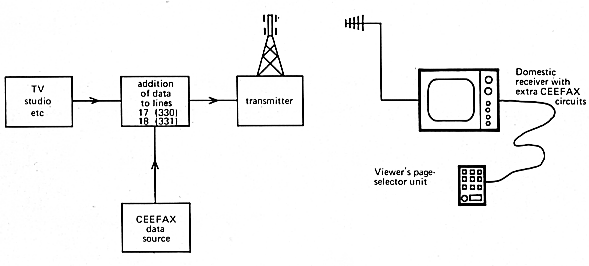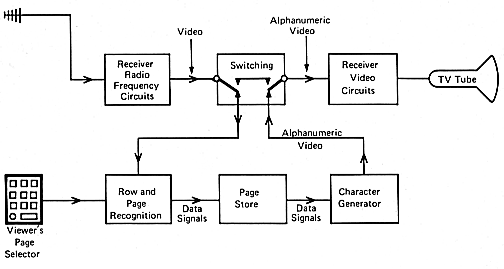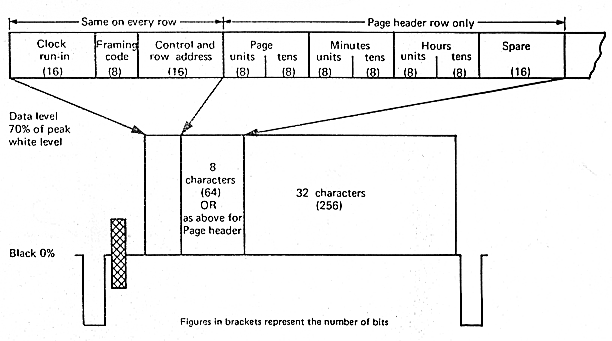 |
The Teletext Museum. |
|
|||||||||||
BBC ENGINEERING INFORMATION
Information Sheet 4008(5), October 1975
|
|
|
|
|
CEEFAX is the BBC's 'dial-a-page' news and information service. It lets the viewer 'see facts' written in words and figures on the television screen. The service is an optional extra and to use it television receivers need a special, built-in decoder. Eventually, a receiver incorporating CEEFAX will cost relatively little more than a standard television set. A television receiver equipped with a CEEFAX decoder has two extra controls that enable the viewer to switch from the ordinary programme and choose one of the 100, coloured, screen-size pages the CEEFAX magazine can provide. News headlines, sports results, weather, travel, Stock Market prices, consumer affairs - CEEFAX covers all of these and more. All the viewer does is to press a button to select the service then dial a three figure number for the page required. |
| CEEFAX was first made known in an announcement by the BBC on 23-Oct-1972 and experimental transmissions began in March 1973. After extensive collaboration with other interested organizations, a United Kingdom unified specification for such an information service was agreed and published. BBC test transmissions changed to the unified standard in April 1974 and an experimental service carrying many different pages, continually updated by a team of editors and researchers began, with the authorization of the Home Office, on 23-Sep-1974. |
|
| Specification of standards for information transmission by digitally coded signals in the field-blanking interval of 625-line television systems, published jointly by the British Broadcasting Corporation, the Independent Broadcasting Authority (IBA) and the British Radio Equipment Manufacturers' Association (BREMA), price 50p, post free. CEEFAX is the BBC's name for the information service; it is known as Teletext to BREMA and ORACLE to the IBA. |
A CEEFAX PAGE
Figures 1 and 2 show what CEEFAX pages look like. Every page can have 24 rows of information with up to 40 characters in every row [except tne page header which has only 32 characters]. The shape of the characters will depend on receiver design but the system is tailored to a 7 x 5 matrix.
The first row of every page is a special row called the 'page header'. The page header will show the page number, the date and the time to the second. The CEEFAX receiver recognises signals transmitted at the beginning of the header row so that it can tell when a page is beginning and which page it is. When the signals match the orders given by the viewer through his page selector the receiver will proceed to display the header row and the text which follows it.
TRANSMISSION
The information is transmitted as a series of coded electronic pulses. Figure 3 shows how the system operates. The pulses are added to two lines in the field blanking period of the television waveform (lines 17 and 18 in one field and 330 and 331 in the next). Each of these television lines carries the coded information for one row of the CEEFAX display. Thus with two lines available for each television field it will take
24 rows ÷ ( 2 rows/field x 50 field/sec ) = 0.24 seconds
to transmit a full page of 24 rows. For good legibility and attractive layout, the average page will contain less than 24 rows of text and is therefore transmitted in less than 0.24 seconds. Complete pages are transmitted one after the other and it may take up to 24 seconds after pushing the selector buttons before the required page appears on the screen.

Figure 3 - CEEFAX basic arrangement
RECEPTION
Like ordinary television, CEEFAX can be disturbed by severe interference but the effect is to produce incorrect characters. However, good CEEFAX reception is possible wherever good television pictures can be received and field tests have shown that CEEFAX works equally well on uhf and vhf transmissions.

Figure 4 - CEEFAX receiver arrangement
EXTENDING A MAGAZINE
The system allows for many refinements. The amount of information that can be shown can be considerably extended by using the pages in the following ways.
Type A pages are single pages of information that
can be rapidly updated. News headlines are shown in this way.
Type B pages can be described as 'rotating' pages.
A complete page of information is transmitted and left unchanged for a
reasonable reading period, perhaps one minute. Then a new text, following on
from the first, automatically takes its place. In this way long lists, for
example of football results, take up the minimum space in the system.
Type C pages are used to carry information which does not need frequent updating and might require to be transmitted only once each day. At the rate of one a minute there can be more than 1,000 'editions' of a particular page in a day, each identified by its own 'address' which, for convenience, is also the time at which it is transmitted. For example, a page addressed 1925 is transmitted at 1925 clock-time. The type C page is preselected by the viewer so that his receiver recognises and stores the required page, to be viewed later at some convenient time. It is conceivable that electronic stores capable of storing many such pages, throughout the day, will become available at an economic price.
CEEFAX can also be used to superimpose subtitles on the normal programmes. This could be useful for deaf viewers or could give an alternative language version of the programme sound. In a similar way the viewer can choose to have newsflashes automatically displayed as soon as they are transmitted.
BRIEF SPECIFICATION

Figure 5 - The organisation of CEEFAX data on lines 17, 18,
330 & 331.
THE CEEFAX WAVEFORM
- Shape: raised cosine
- Amplitude: approximately 70% of the black to white excursion
- Clock rate: 6.9375 MHz
- Logic: positive: a data pulse corresponds to '1', no pulse corresponds to '0'
- System coding: NRZ (non-return-to-zero): a simple 'on/off' binary code
Clock and identification pulses
Clock run-in: 16 bits are allocated to a simple sequence of pulses that brings the receiver 'clock' into step with the transmitted data.
Framing-code: the framing code is to allow the receiver to achieve word synchronism with the data which follows.
Data pulses
Information carrying pulses fall into two groups; the addresses, which tell the receiver the number of the row and page being transmitted, and the characters. Each group uses different transmission codes.
Addresses of pages and rows are transmitted in binary coded decimal (BCD). This simplifies the receiver circuits needed to detect a match between the receiver's page selector and the number of the page being transmitted. A Hamming system is used to protect each BCD digit which then occupies 8 bits. The Hamming technique enables single errors to be corrected. Addresses transmitted in this way are:
Control and row address: enables the receiver to identify the row being transmitted so that each row of information is displayed in the correct location on the screen. With an address for each row, blank rows need not be transmiitted.
Row address: also serves to indicate the beginning of a page.
- Page address- The page address occupies part of the page header row. The address (in BCD) indicates the page number and the time of transmission (to the minute). These factors initiate storage and display of the selected CEEFAX page.
Characters are transmitted in a seven-bit code which allows for a wide range of alpha-numeric characters. An eighth parity bit is added for error protection. Odd parity is used. One television line can carry a complete row of 40 characters but when the row is the page header only 32 characters can be accommodated because the page address (see above) takes up 64 bits (equivalent to 8 characters).
Teletext Timeline | Teletext links
|
|||
|